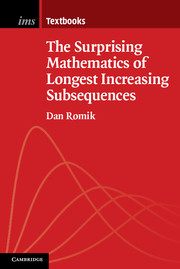Book contents
- Frontmatter
- Contents
- Preface
- 0 A few things you need to know
- 1 Longest increasing subsequences in random permutations
- 2 The Baik–Deift–Johansson theorem
- 3 Erdős–Szekeres permutations and square Young tableaux
- 4 The corner growth process: limit shapes
- 5 The corner growth process: distributional results
- Appendix Kingman's subadditive ergodic theorem
- Notes
- References
- Index
3 - Erdős–Szekeres permutations and square Young tableaux
Published online by Cambridge University Press: 05 October 2014
- Frontmatter
- Contents
- Preface
- 0 A few things you need to know
- 1 Longest increasing subsequences in random permutations
- 2 The Baik–Deift–Johansson theorem
- 3 Erdős–Szekeres permutations and square Young tableaux
- 4 The corner growth process: limit shapes
- 5 The corner growth process: distributional results
- Appendix Kingman's subadditive ergodic theorem
- Notes
- References
- Index
Summary
Chapter summary. We continue our study of longest increasing subsequences in permutations by considering a special class of permutations called Erdőos-Szekeres permutations, which have the property that their longest monotone subsequence is the shortest possible and are thus extremal cases demonstrating sharpness in the Erdőos-Szekeres theorem. These permutations are related via the Robinson-Schensted correspondence to an especially well-behaved class of standard Young tableaux, the square Young tableaux. We use the tools developed in Chapter 1 to analyze the behavior of random square Young tableaux, and this leads us to an interesting result on the limiting shape of random Erdőos-Szekeres permutations. We also find a mysterious arctic circle that appears when we interpret some of the results as describing the asymptotic behavior of a certain interacting particle system.
Erdős–Szekeres permutations
In the previous two chapters we studied the statistical behavior of the permutation statistic L(σ) for a typical permutation σ chosen at random from among all permutations of given order. In this chapter we focus our attention instead on those permutations σ whose behavior with regard to longest increasing subsequences, or more precisely longest monotone subsequences, is atypical in the most extreme way possible. We refer to these permutations as Erdős–Szekeres permutations, because of their role as extremal cases demonstrating the sharpness in the Erdős-Szekeres theorem (Theorem 1.2).
- Type
- Chapter
- Information
- The Surprising Mathematics of Longest Increasing Subsequences , pp. 157 - 210Publisher: Cambridge University PressPrint publication year: 2015



